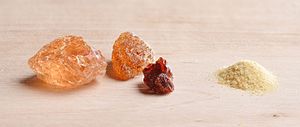Note: This is a project under development. The articles on this wiki are just being initiated and broadly incomplete. You can Help creating new pages.
Vachellia nilotica - Gum arabic
Gum arabic,[1] also known as acacia gum, is a natural gum consisting of the hardened sap of various species of the acacia tree. Originally, gum arabic was collected from Acacia nilotica which was called the "gum arabic tree"; in the present day, gum arabic is predominantly collected from two related species, namely Acacia senegal and Vachellia (Acacia) seyal. Producers harvest the gum commercially from wild trees, mostly in Sudan (80%) and throughout the Sahel, from Senegal to Somalia—though it is historically cultivated in Arabia and West Asia.
Gum arabic is a complex mixture of glycoproteins and polysaccharides. It is the original source of the sugars arabinose and ribose, both of which were first discovered and isolated from it, and are named after it.
Gum arabic is used primarily in the food industry as a stabilizer. It is edible and has E number E414. Gum arabic is a key ingredient in traditional lithography and is used in printing, paint production, glue, cosmetics and various industrial applications, including viscosity control in inks and in textile industries, though less expensive materials compete with it for many of these roles.
While gum arabic is now produced throughout the African Sahel, it is still harvested and used in the Middle East. For example, Arab populations use the natural gum to make a chilled, sweetened, and flavored gelato-like dessert.
Uses
- Gum arabic's mixture of polysaccharides and glycoproteins gives it the properties of a glue and binder that is edible by humans.
- Other substances have replaced it where toxicity is not an issue, and as the proportions of the various chemicals in gum arabic vary widely and make it unpredictable. Still, it remains an important ingredient in soft drink syrup and "hard" gummy candies such as gumdrops, marshmallows, and M&M's chocolate candies.
- For artists, it is the traditional binder in watercolor paint, in photography for gum printing, and it is used as a binder in pyrotechnic compositions.
- Pharmaceutical drugs and cosmetics also use the gum as a binder, emulsifying agent, and a suspending or viscosity increasing agent.
- Wine makers have used gum arabic as a wine fining agent.
- It is an important ingredient in shoe polish, and can be used in making homemade incense cones.
- It is also used as a lickable adhesive, for example on postage stamps, envelopes, and cigarette papers. Lithographic printers employ it to keep the non-image areas of the plate receptive to water. This treatment also helps to stop oxidation of aluminium printing plates in the interval between processing of the plate and its use on a printing press.
- Gum arabic is used as an emulsifier and a thickening agent in icing, fillings, chewing gum and other confectionery treats.
Common name
- English - Babul
- Kannada - Babli
- Hindi - कीकर
